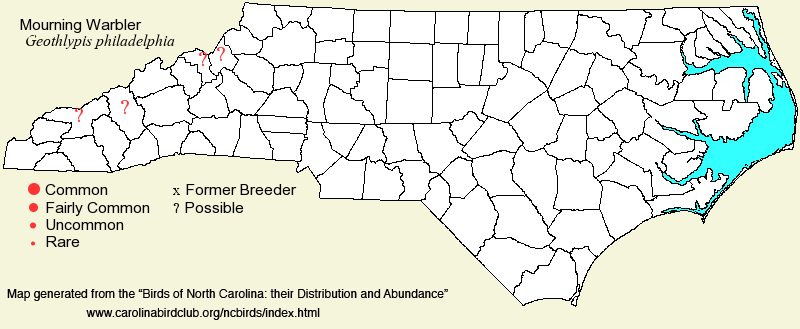 |  |
|
Mourning Warbler - Geothlypis philadelphia PARULIDAE Members: | Search Common: Search Scientific: |
|
|
|||||||
| General Comments | The Mourning Warbler, until 2011, was placed in the same genus (Oporornis) with the Connecticut Warbler, which has a similar appearance to Mourning and MacGillivray's warblers. However, the Connecticut Warbler walks, whereas the Mourning and most other warblers are unable to walk, but must hop on the ground; likely this important structural and behavioral trait is one of the reasons for the split of the two into different genera. The Mourning has been placed into the same genus (Geothlypis) as the yellowthroats and the Kentucky Warbler. At any rate, both the Mourning and the Connecticut nest across southern Canada and the northern part of the United States. The Mourning also breeds sparingly south into the central Appalachians, to West Virginia and Virginia, and on a number of recent occasions has appeared in North Carolina in the nesting season, even with singing males on territory for a week or longer. It is a scarce and very secretive migrant in the East, though in coastal Texas it can be numerous (because migrants tend to avoid flying over the Gulf of Mexico). In the breeding season, Mournings are found mainly in thickets in openings in cool coniferous forest areas (bog margins); in North Carolina, they have been found mainly in dense shrubby growth in openings in forests, at fairly high elevations. In migration, they can be found in such tangles and thickets, as well; they are not a forest-interior dweller. However, they are extremely quiet and secretive, and glimpses are often all that one sees. | ||||||
| Breeding Status | Probable Breeder | ||||||
| NC BRC List | Definitive | ||||||
| State Status | W | ||||||
| U.S. Status | |||||||
| State Rank | SUB,SZN | ||||||
| Global Rank | G5 | ||||||
| Coastal Plain | Transient. Casual in spring, so far only along or near the coast; very rare in fall along the immediate coast, and essentially accidental farther inland. Only 5 spring reports (20 May to 2 Jun); in fall, mainly early Sep to mid-Oct; about 23 reports. One (adult female) in Halifax on 15 Jul 1989 was quite an early migrant. Peak counts: one. | ||||||
| Piedmont | Transient. In spring, very rare in the western half of the province and casual in the eastern half; in fall, very rare throughout. One was quite far east near Garner (Wake) on 24 May 2025. Mainly mid- to late May (all dates are from 8 May - 3 Jun), and mid-Aug to early Oct. Peak counts: one. | ||||||
| Mountains | Transient; also very rare (in the past few decades) in summer, and probable breeder, though as yet with no strong nesting evidence found. A pair were present during the summers of 1983 and 1984 at Jenkins Ridge Overlook in the Great Smoky Mountains (Haywood), appearing to be on territory and exhibiting some evidence of breeding [Chat 54:79-80 link]. A singing male was in the same location in the summer of 1985. A singing and apparently unpaired male was also seen at Roan Mountain in Jun-Jul of 2001 and 2002 [Chat 66:34 link], [Chat 66:155 link]. Another singing male was at Richland Balsam Overlook, milepost 431 on the Blue Ridge Parkway, on the border of Jackson and Haywood, 5-19 Jun 2012 [Chat 76:138-39 link]. In 2014, a singing male was at Black Balsam Knob (Haywood) from 8-21 Jun; and another singing male was at Sugar Creek Gap (Jackson) on several dates in Jun [Chat 78:169 link]. In 2015, one was again singing at Black Balsam Knob, from 4-26 Jun. In 2017, a singing male was present close to the Linn Cove Viaduct along the Blue Ridge Parkway (Avery) from 20 May - 21 Jun. In spring, very rare, mainly at low elevations (mostly below 3,000 feet); in fall, rare, but regular, across the region. A more "numerous" transient in the mountains than elsewhere in the state, in both spring and in fall. Routinely found by Burleigh in the 1930's in the Asheville area in the fall, and not considered rare. Mainly mid-May to early Jun, and mid-Aug to early Oct; a few records as early as 2 May. Peak counts: 2, Jackson Park (Henderson), 17 Sep 2008. | ||||||
| Finding Tips |
This is a difficult bird to find in the state, because relatively few pass through, and then mainly in the mountains in fall; and, they are very secretive. Most serious birders have seen one or more of the territorial birds in the early summer season. Otherwise, your best bet is to work hard at Jackson Park in Hendersonville in late Aug or Sep, but seeing one in a given week is unlikely, even if one is present! * | ||||||
| Attribution | LeGrand[2025-10-24], LeGrand[2025-07-29], LeGrand[2025-04-21] | ||||||
| NC Map Map depicts all counties with a report (transient or resident) for the species. | Click on county for list of all known species. |
| NC Breeding Season Map Map depicts assumed breeding season abundance for the species. |  |